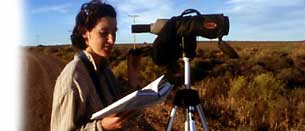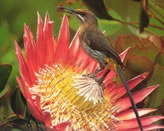Grootvadersbosch
Nature Reserve:
The extensive wilderness area of the Groot-vadersbosch Nature
Reserve incorporates a 250-hectare indigenous forest, the largest
in the southwestern Cape and certainly the region’s richest
in bird diversity. A number of more characteristically eastern
species reach their western limit here, and most are not difficult
to find with a little patience and persistence, particularly
in spring when they are at their most vocal. There is also good
birding along the disturbed forest edges and in the adjacent
moist mountain fynbos. Sought-after endemics that can be found
at Grootvadersbosch reserve include Knysna
Woodpecker (p.72*), Knysna
(p.32*) and Victorin’s
(p.73*) Warblers, Forest Canary and Cape
Siskin (p.33*), as well a host of exciting forest specials
such as Narina Trogon (p.125*) and Crowned Eagle.
To
reach Grootvadersbosch, take the N2 national road east of
Swellendam for 11 km, then turn left onto the R324 (signposted
‘Suurbraak/Barrydale’). Continue along this road,
perhaps stopping to scan the lily- and reed-fringed pond on
the left, that sometimes hosts Giant Kingfisher, African
Rail and White-backed Duck. Pearl-breasted Swallow
is also very often seen along this road. Pass through the
picturesque village of Suurbraak, checking any flowering coral
trees (Erythrina caffra) for feeding sunbirds, notably
Black Sunbird. Where the road forks (the first fork
is 26 km from the N2), follow the signposts to Grootvadersbosch
(or ‘Boosmansbos Wilderness Area’). The ‘grootvader’
(grandfather) of the forest’s name was an 18th-century
Dutch farmer to whom the land was first assigned. From Suurbraak
to the reserve, the road passes over a series of rolling hills
over which Black
Harrier (p.57*) regularly hunt.
The
reserve entrance (at 1 on map, above) is on a ridge overlooking
the forested valleys and the Langeberg range. Next to the
entrance is a parking area, an information centre and a beautifully-situated
campsite. Groups of Cape
Siskin invariably forage around the campsite, and
Greater Double-collared Sunbird feed in the garden
of the office, where you need to obtain a day permit to enter
the forest. From here it is a short, steep walk down a bracken-covered
slope known as Bosbokrand (‘Bushbuck Ridge’; 2 on
map) before you enter the forest on an excellent network of
paths. West of the ridge, the forest is predominantly slightly
drier and lower than that to the east of the ridge. A gentle
walk of roughly three hours (allowing time for lots of birding)
is a 1.7 km loop through the eastern valley, described below.
However, you might also want to make a short foray into the
western portion of the forest, or into the moist, fynbos-clad
slopes above.
Disturbed
areas, such as those on the descent from the campsite to the
forest edge at Bosbokrand, are the favoured feeding habitat
of several seedeaters, including small flocks of Swee Waxbill,
Forest Canary and Cape
Siskin. This is also a good place to look for foraging
Black Saw-wing Swallows, and for raptors. Crowned
Eagle reaches its western limit at Grootvadersbosch, and
is regularly seen overflying this ridge; more common forest
raptors are Forest Buzzard, Black Sparrowhawk
and African Goshawk. These are often seen perching
on the skeletons of the introduced Giant Redwoods that protrude
through the canopy at various places in the forest. Cuckoo
Hawk has also been seen here in recent years.
From
Bosbokrand, turn right at 3 onto the signposted ‘Redwoods
Road’, a gravel track winding down the slope’s lower
contour. Walking down this track early in the morning, you
are likely to catch glimpses of the Cape’s westernmost
Red-necked Francolins, scurrying off the path edge
or calling tantalizingly fifty or so metres ahead. The most
common and conspicuous birds in the forest are Sombre Bulbul,
Cape Batis and Bar-throated Apalis. Before long,
however, you will intercept a bird party and thus be likely
to encounter Olive Wood-pecker, Terrestrial Bulbul,
Paradise and Blue-mantled Flycatchers, Yellow-throated
Warbler and Greater Double-collared Sunbird. While
all of these are very vocal, some, such as Terrestrial
Bulbul and Olive Bush Shrike, are inconspicuous
lurkers, and you will need to invest a little time before
obtaining good
views.
After
a gentle descent, the path turns sharply to the left and crosses
the Duiwenhoks River. The streamside undergrowth holds Knysna
Warbler, typically vocal yet skulking as ever (p.32*).
This junction is also a good spot for Knysna
Woodpecker (p.72*), which is not uncommon in the forest,
as evidenced by its very distinctive, shrieking call. The
challenge to birders lies in that this species only calls
at 10–15 minute intervals, though it can often be located
by following its soft but more regular tapping. Olive Woodpecker,
conversely, is both vocal and conspicuous.
Ignore
the continuation of the broad gravel track at 4, and turn
left along the footpath back up the northern slope of the
valley, where the forest is taller and moister. The forest
clearing a few hundred metres up this path is a good spot
to look for over-flying raptors. Also look out for Grey
Cuckooshrike, a subtly beautiful canopy species that,
though fairly common, requires a little alertness to its peculiarly
sibilant call, vaguely reminiscent of that of Dusky Flycatcher.
Another stunning canopy bird that reaches its western limit
at Grootvadersbosch is the Narina
Trogon (p.125*). It is surprisingly easy to locate
once you become familiar with its repetitive, hoarse hooting
call. Listen for it in the vicinity of the canopy hide at
5, as well as elsewhere in the forest. Throughout the forest,
look out for South Africa’s most westerly Bushbuck (Tragelaphus
scriptus), which bark startlingly as they make a crashing
escape through the dense undergrowth ahead.
Returning
to Bosbokrand, you might want to make a short detour to the
other canopy hide at 6 (500 m down the signposted ‘Melkhoutpad’,
that follows a higher contour down the same valley as the
Redwoods Road). This hide provides an excellent vantage point
from which to scan for raptors, which often perch on the skeletons
of the introduced redwoods across the valley from this hide.
North
of Bosbokrand, a gravel track (7 on map) soon leads into moist
fynbos to become the beginning of the Boosmansbos Hiking Trail,
a route that leads the rugged on a two-day loop among the
Langeberg peaks. Victorin’s
Warbler (p.73*) is very common here, even a few hundred
metres from the forest edge. Red-wing Francolin also
occurs on these slopes, but is decidedly scarce.
|


